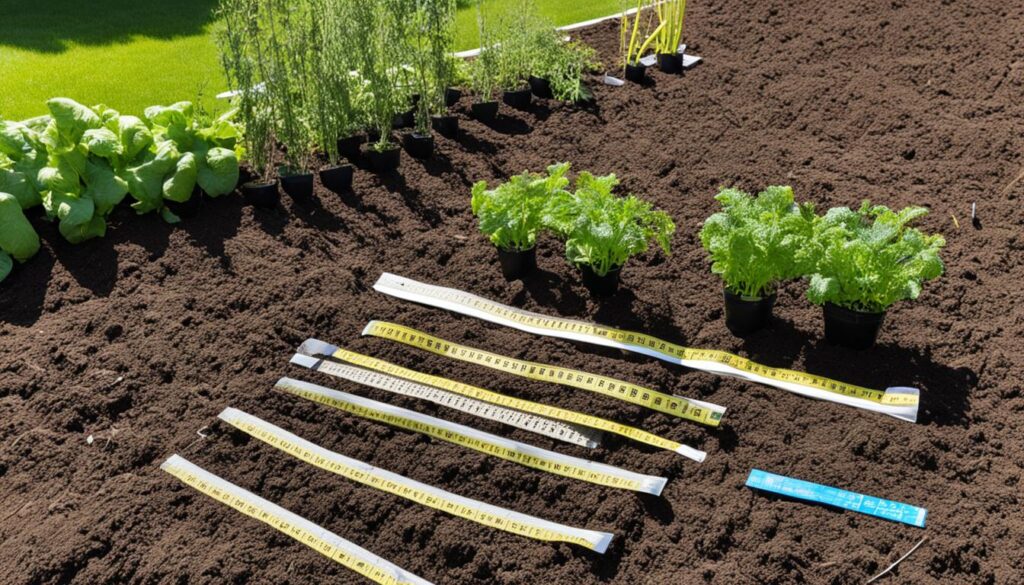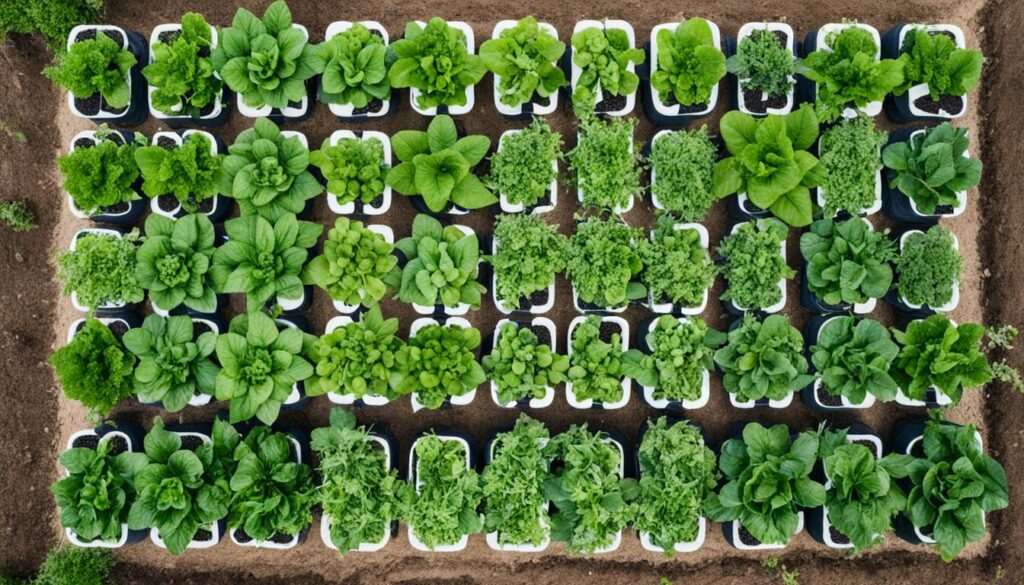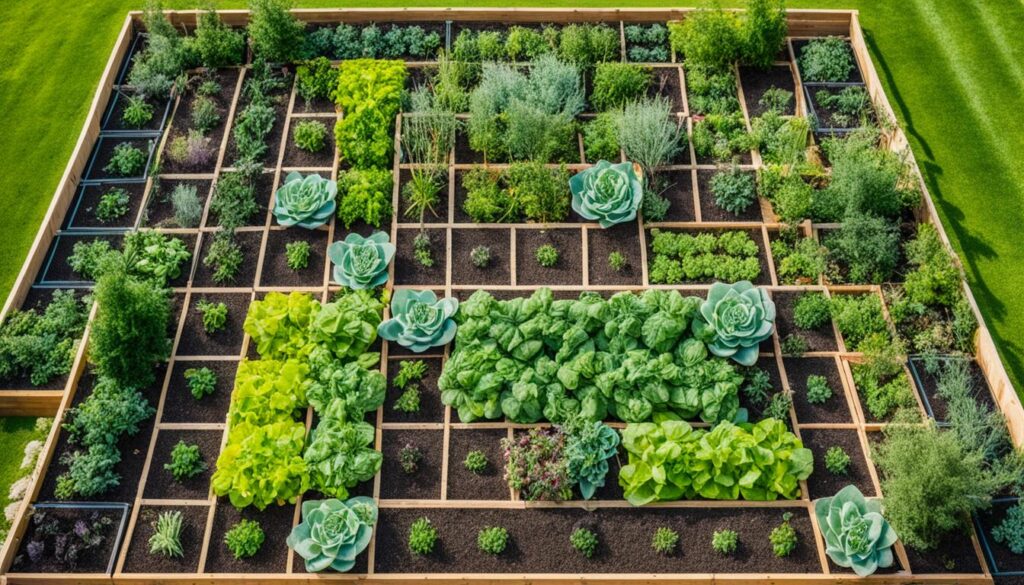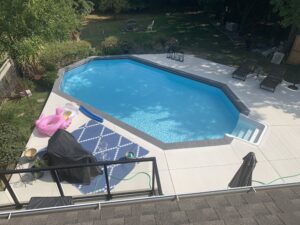Welcome to the world of vegetable gardening! Whether you’re a seasoned green thumb or a first-time gardener, planning your vegetable garden is the foundation for a successful and rewarding experience. From selecting the right plants to ensuring proper sunlight and watering, each step requires thoughtful consideration to create an optimal environment for your vegetables to thrive.
Vegetable gardening at home offers numerous benefits. Not only is it a cost-effective way to enjoy fresh produce, but it also allows you to connect with nature and experience the satisfaction of growing your own food. Starting with just a few plants can yield a significant amount of vegetables, saving you money compared to buying them from the store. And let’s not forget the exceptional taste of home-grown produce – it’s simply unmatched!
Before you dive into the world of vegetable gardening, it’s important to consider a few key factors. Assess your level of commitment and the amount of produce you and your family can consume. This will help you determine the size of your garden and the types of vegetables to grow. Remember, starting small is always a wise choice for beginners.

Key Takeaways:
- Planning your vegetable garden is essential for a successful gardening experience.
- Home-grown produce is cost-effective, delicious, and allows you to connect with nature.
- Consider your level of commitment and the amount of produce you can consume.
- Starting small is recommended for beginners.
- Stay tuned for expert tips on starting small and choosing the right vegetables for your garden.
Click HERE to buy The Old Farmer’s Almanac Vegetable Gardener’s Handbook from Amazon
Starting Small: Beginner’s Tips
For beginners who are new to vegetable gardening, starting with a small garden is a great way to get started. By beginning with a manageable size, you can effectively manage your time, resources, and learn the basics of gardening. A 6×6 feet garden is ideal for beginners.
Choose up to five types of vegetables that you enjoy and plant a few of each. This will provide you with a variety of vegetables for your meals without overwhelming you with too many responsibilities. It’s important to choose vegetables that are suitable for your climate and growing conditions.
If you don’t have a yard or outdoor space, don’t worry! You can still pursue your gardening dreams with container gardening. Utilize a sunny deck or balcony and grow your vegetables in containers. This allows you to have a mini-garden and enjoy the benefits of fresh produce.
Remember, starting small allows you to learn and adapt as you go. It’s a great way to build confidence and gradually expand your gardening efforts.
| Vegetable | Difficulty Level | Recommended Growing Zone |
|---|---|---|
| Tomatoes | Easy | Zone 3-11 |
| Lettuce | Easy | Zone 2-11 |
| Radishes | Easy | Zone 2-10 |
| Green beans | Easy | Zone 2-11 |
| Zucchini | Moderate | Zone 3-11 |
Quote: “Starting small is a wise approach for beginners in vegetable gardening. It allows you to learn and grow your skills as you go, without overwhelming yourself with too much work.” – Jane Smith, experienced gardener
Choosing What to Grow
Click HERE to order an assortment of vegetable and herb seeds from Amazon
When it comes to planning your vegetable garden, one of the most important decisions you’ll make is choosing what to grow. By selecting the right vegetables, you can ensure a bountiful harvest of delicious and nutritious produce. Here are some best practices to consider:
Variety and Preference
Start by considering the vegetables that you and your family enjoy eating. After all, what’s the point of growing vegetables that no one will eat? Take into account your personal preferences, as well as any dietary restrictions or allergies. This will make sure that the vegetables you grow will be enjoyed and not go to waste.
Read the Seed Packets
Before making your final selections, take the time to read the seed packets or labels of the vegetables you’re considering. These packets provide valuable information about each variety, including the size of the mature plants, their care needs, and the estimated time to harvest. Understanding these characteristics will help you determine if a particular vegetable is suitable for your garden.
Consider Yield
Think about the amount of produce you and your family will realistically consume. Some vegetables, like tomatoes and peppers, produce continuously throughout the season, while others, like lettuce and radishes, have a shorter harvest window and need to be replanted. By planning for a variety of vegetables with different harvest schedules, you can ensure a continuous supply of fresh produce.
Weather Considerations
Another important factor to consider is the weather in your region. Certain vegetables thrive in cool weather, while others prefer the warmth. By including a mix of cool-weather and warm-weather vegetables in your garden, you can enjoy a diverse array of produce throughout the seasons. Cool-weather vegetables include broccoli, carrots, and spinach, while warm-weather vegetables include tomatoes, cucumbers, and peppers.
By taking these best practices into account, you can make informed decisions about what to grow in your vegetable garden. Remember to choose vegetables that you enjoy, read the seed packets, consider yield and weather, and plan for a variety of harvest schedules. With careful planning, your vegetable garden will flourish and provide you with an abundance of fresh and tasty produce.

START Now! Click HERE to order some small pots from Amazon to get things growing indoors first
Sunlight and Water Requirements
Sunlight and water are essential factors that contribute to the success of your vegetable garden. Proper planning and consideration of these requirements are crucial for effective vegetable garden planning.
Most vegetables thrive when they receive at least 6 to 8 hours of direct sunlight per day. This allows them to photosynthesize and grow optimally. Ensure that your garden is positioned in an area that receives adequate sunlight and is not blocked by trees, structures, or other obstructions.
The availability of a nearby water source is also important for easy access to water your plants. Consider the proximity of your garden to a water outlet or install a water collection system to make watering more convenient.
Newly planted vegetables require frequent watering, especially during the establishment phase when they are developing strong roots. It’s recommended to provide a deep watering every few days rather than shallow daily sprinkling. Deep watering encourages the roots to grow deeper into the soil and promotes healthier plants.
Sunlight and Water Requirements for Common Vegetables
| Vegetable | Sunlight Requirements | Watering Needs |
|---|---|---|
| Tomatoes | 6-8 hours of direct sunlight | Moderate watering; keep soil consistently moist |
| Lettuce | 4-6 hours of direct sunlight | Frequent watering; keep soil evenly moist |
| Cucumbers | 6-8 hours of direct sunlight | Adequate watering; soil should be consistently moist |
| Carrots | 4-6 hours of direct sunlight | Regular watering; soil should be consistently moist but not waterlogged |
| Peppers | 6-8 hours of direct sunlight | Moderate watering; water deeply but allow the soil to dry slightly between waterings |
By understanding the sunlight and water requirements of different vegetables, you can strategically plan your garden layout and watering schedule, ensuring that your plants receive the optimal conditions for growth and productivity.
Click HERE to order an assortment of vegetable and herb seeds from Amazon
Garden Layout and Plant Spacing
When it comes to planning your vegetable garden, choosing the right layout and plant spacing is essential. There are two main approaches you can consider: row cropping and intensive cropping.
Row cropping: This method involves planting vegetables in straight rows with ample spacing between each plant. This layout makes it easier for garden maintenance tasks such as weeding, watering, and harvesting. With clear pathways between rows, you can access each plant without damaging surrounding vegetation. It also allows better airflow and sunlight penetration, reducing the risk of diseases.
Intensive cropping: On the other hand, intensive cropping maximizes space by planting vegetables in grids or raised beds. This design makes the most efficient use of limited space, perfect for small gardens or urban settings. By closely planting vegetables, you can increase yield and minimize the growth of weeds. However, proper plant spacing is crucial to ensure each plant has enough room to grow and access sunlight and nutrients.
Before deciding on your garden layout, assess the size and needs of your garden. Consider the mature size of each plant, as well as the accessibility required for maintenance and harvesting. Here are a few tips to help you plan your layout:
- Research the recommended plant spacing for each type of vegetable you plan to grow:
For example, tomatoes typically require 2 to 3 feet between plants, while lettuce can be planted as close as 8 to 12 inches apart.
- Use companion planting techniques to optimize space:
Some plants have mutually beneficial relationships that can help deter pests or attract beneficial insects. For instance, planting marigolds next to tomatoes can repel harmful nematodes.
- Create pathways between garden beds:
Having clearly defined pathways allows easy access for maintenance tasks and prevents compaction of the soil in planted areas.
Here’s an example of how you can visually plan your garden layout:
| Plant | Spacing | Planting Method |
|---|---|---|
| Tomatoes | 2-3 feet | Row cropping |
| Lettuce | 8-12 inches | Intensive cropping |
| Cucumbers | 1-2 feet | Row cropping |

By carefully planning your garden layout and plant spacing, you can optimize your space, maximize yields, and create an organized and visually appealing vegetable garden.
Soil Preparation and Soil Testing
Preparing your soil is crucial for creating a successful vegetable garden plan. The quality of your soil directly affects the growth and productivity of your plants. By following these steps, you can ensure that your vegetable garden has the optimal conditions for a bountiful harvest.
Assessing Soil Texture and Composition
Start by assessing the texture and composition of your soil. Ideally, it should be dark, crumbly, and well-draining. You can perform a simple test by taking a handful of soil and squeezing it. If it easily crumbles when you open your hand, that’s a good indication of well-draining soil. On the other hand, if it forms a tight ball or feels dense and compacted, your soil may need improvement.
If your soil is heavy clay or sandy, it is beneficial to add organic matter to improve its structure. Organic matter, such as compost, helps loosen compacted soil and allows for better root penetration and water retention.
Improving Soil Quality with Organic Matter
Adding organic matter is one of the best ways to enrich your soil and create a nutrient-rich environment for your plants. Compost is an excellent source of organic matter and can be easily created at home using kitchen scraps, yard waste, and other organic materials. Spread a layer of compost over the garden bed and mix it into the top few inches of soil.
Compost improves soil structure, enhances moisture retention, and increases nutrient availability. It also helps beneficial soil organisms thrive, creating a healthier ecosystem for your plants.
Soil Testing for pH and Nutrient Levels
While visually assessing your soil can provide some insights, soil testing is a valuable tool for creating an optimal vegetable garden plan. Sending a soil sample to a certified lab for testing can provide accurate information about your soil’s pH level and nutrient content.
Soil pH: The pH level of your soil affects nutrient availability to your plants. Most vegetables thrive in slightly acidic to neutral soil, with a pH range of 6.0 to 7.0. Based on the soil test results, you can adjust the pH by adding lime to raise the pH or sulfur to lower it.
Nutrient Levels: Soil testing also reveals the nutrient levels in your soil, such as nitrogen, phosphorus, and potassium. These macronutrients are vital for healthy plant growth. Based on the test results, you can determine if your soil lacks any essential nutrients and make appropriate amendments, such as adding organic fertilizers or specific nutrient supplements.
| Nutrient | Optimal Range | Deficiency Symptoms |
|---|---|---|
| Nitrogen | 0.5%-2.0% | Stunted growth, pale leaves |
| Phosphorus | 0.2%-0.5% | Purple leaves, poor root development |
| Potassium | 1.0%-4.0% | Yellowing leaves, weak stems |
Soil testing provides valuable information for creating a successful vegetable garden plan. It helps you understand the specific needs of your soil, allowing you to make targeted amendments to optimize plant growth and overall garden health.
Pest and Weed Management
Pest and weed control is essential for maintaining the health of your vegetable garden. Invasive pests and weeds can compete for vital nutrients and water, ultimately affecting the growth and productivity of your plants. By implementing effective pest and weed management strategies, you can ensure the success of your vegetable garden.
Mulching: Mulching is an effective and natural way to suppress weed growth and conserve moisture in your garden. Cover the soil around your larger plants with clean straw or compost. This layer acts as a barrier, preventing sunlight from reaching weed seeds and inhibiting their germination. Mulching also helps regulate soil temperature and prevent erosion, contributing to overall plant health.
Fencing: For larger pests like deer and rabbits, installing fences around your garden can provide a physical barrier of protection. Choose sturdy materials such as wire mesh or deer netting to prevent these animals from accessing your crops. Fence height should be sufficient to deter their entry and ensure the safety of your plants.
Manual Pest Removal: Handpicking insects and removing them manually is an effective and environmentally friendly pest control method. Inspect your plants regularly and remove any pests you find, such as beetles, caterpillars, or aphids. This process can be time-consuming but is highly beneficial for maintaining the health of your vegetable garden.
Insecticidal Soap Sprays: If you have a larger infestation of pests, using insecticidal soap sprays can help control their population. These soaps are specifically formulated to target and kill common garden pests without harming beneficial insects. Follow the instructions on the product label carefully to ensure safe and effective use.
Companion Planting: Implementing companion planting techniques can naturally deter pests from your vegetable garden. Certain plant combinations, such as marigolds with tomatoes or basil with peppers, can repel common pests like aphids or tomato hornworms. Research suitable companion plants for the vegetables you are growing and create a natural barrier against pests.
Regular Weeding: Regular weeding is crucial for preventing weed competition in your vegetable garden. Weeds can quickly take over and deprive your plants of the necessary resources for growth. Set aside time each week to remove any weeds, ensuring that they are completely uprooted to prevent regrowth.
By incorporating these pest and weed management strategies into your vegetable garden planning, you can create a thriving and productive garden space. Protect your plants from pests and ensure they have the necessary resources for optimal growth.
Plan Your Watering System
A reliable watering system is crucial for the success of your vegetable garden. Adequate hydration ensures that your plants receive the necessary moisture to grow and thrive. Here are some steps to effectively plan your watering system:
- Locate a water source: Ensure that your garden is within close proximity to a water source, such as an outdoor faucet. This makes it convenient for you to access and provide water to your plants.
- Consider rainwater harvesting: In areas where water is scarce or expensive, consider supplementing your watering system with rainwater collected in barrels. This sustainable practice not only conserves water but also reduces your water bill.
- Implement proper watering techniques: Deep watering is essential to encourage the development of strong root systems. This involves providing a thorough soak, allowing the water to penetrate deep into the soil. Consider using soaker hoses or drip irrigation systems, as they maximize water efficiency by delivering water directly to the root zone.
By implementing an effective watering system, you can ensure that your vegetable garden receives the necessary moisture for optimum growth and productivity.
Benefits of a Well-Planned Watering System
A well-planned watering system offers numerous benefits for your vegetable garden:
- Healthy plant growth: Proper hydration promotes healthy plant growth, leading to larger, tastier vegetables.
- Water conservation: By using water efficiently and collecting rainwater, you can conserve this valuable resource and reduce your environmental impact.
- Time-saving: An efficient watering system minimizes the time and effort required to manually water your plants, allowing you to focus on other garden tasks and activities.
- Improved water absorption: Deep watering techniques and drip irrigation systems ensure that water reaches the root zone efficiently, preventing wastage and promoting better water absorption.
Investing time in planning your watering system will greatly contribute to the overall success of your vegetable garden.
| Watering Methods | Advantages | Disadvantages |
|---|---|---|
| Soaker Hoses | – Delivers water directly to the root zone – Minimizes evaporation and runoff | – Requires careful placement to ensure even distribution |
| Drip Irrigation | – Precise water delivery – Water-efficient – Ideal for individual plant beds | – Initial setup cost – Regular maintenance needed |
| Sprinklers | – Easy to install and use – Suitable for large areas | – Increased water loss due to evaporation – Uneven distribution |
Garden Pathways and Accessibility
Designing garden pathways is an essential aspect of effective vegetable garden planning. Creating clear and accessible pathways not only improves the appearance of your garden but also makes maintenance tasks easier to accomplish.
To ensure easy access and maneuverability, it is important to make the pathways wide enough to comfortably work in the garden beds and accommodate tools like a wheelbarrow if needed. This allows you to navigate the garden without causing damage to plants or soil.
You have several options when it comes to choosing the materials for your garden pathways. Whether you prefer the classic look of paved paths, the natural feel of gravel, or the rustic charm of woodchips, the choice depends on your garden aesthetics and personal preference.
Whichever material you choose, make sure the pathways are well-maintained and provide easy access to all areas of your vegetable garden. This ensures efficient care and an enjoyable harvest experience.
| Pathway Material | Pros | Cons |
|---|---|---|
| Paved | – Provides a clean and neat appearance | – Can be expensive to install – May require professional help for proper installation |
| Gravel | – Allows for good drainage – Can be easily installed | – Requires regular maintenance – Weeds may grow through the gravel |
| Woodchips | – Natural, organic look – Affordable and easy to install | – Needs regular replenishing – Can attract pests like termites |
Remember, the goal is to create pathways that are not only functional but also visually appealing. Find the balance between practicality and aesthetics that suits your unique garden space.
In addition to considering the type of pathway, be mindful of their placement to ensure easy access to all areas of your vegetable garden. Well-designed pathways will facilitate efficient care and harvesting, allowing you to enjoy the fruits of your labor.
Conclusion
Planning your vegetable garden is essential for creating a successful and enjoyable gardening experience. By taking into account important factors such as sunlight, water, plant selection, layout, soil preparation, pest management, watering systems, and garden pathways, you can establish an optimal environment for your plants to thrive.
Starting with a small garden and gradually expanding as you gain experience is a smart approach. Learning from your successes and challenges along the way, you can adapt your planning and techniques to meet the specific needs of your garden.
With proper planning and care, you’ll be rewarded with a bountiful harvest of home-grown vegetables. Enjoy the satisfaction of knowing exactly where your food comes from, the joy of flavorful produce, and the connection to nature that vegetable gardening provides. Get started today and create your own thriving vegetable garden!
FAQ
How do I start planning my vegetable garden?
When planning your vegetable garden, consider factors such as sunlight, water, plant selection, layout, soil preparation, pest management, watering systems, and garden pathways. Start by assessing your space, determining your level of commitment, and choosing the vegetables you and your family enjoy eating.
What is the best way to start a vegetable garden as a beginner?
For beginners, it’s best to start with a small vegetable garden to manage your time and resources effectively. Consider starting with a 6×6 feet garden or container gardening on a sunny deck or balcony. Choose up to five types of vegetables that you enjoy and plant a few of each to provide enough produce for your meals without overwhelming responsibilities.
How do I choose what vegetables to grow in my garden?
When deciding what to grow in your vegetable garden, consider the vegetables you and your family enjoy eating. Read the seed packets or labels to understand the characteristics of each variety, such as size and care needs. Plan to include both cool-weather and warm-weather vegetables for a continuous harvest throughout the seasons.
How much sunlight and water do vegetables need?
Most vegetables need at least 6 to 8 hours of direct sunlight per day. Ensure that your garden receives adequate sunlight and is not blocked by trees or structures. When it comes to water, new plants require frequent watering until they establish strong roots. It’s better to provide a deep watering every few days rather than a daily sprinkle.
What is the best garden layout for vegetables?
There are two main approaches to garden layout: row cropping and intensive cropping. Row cropping involves planting vegetables in straight rows with ample spacing, while intensive cropping involves close planting in grids or raised beds. Determine the best layout based on your garden size and needs, considering the mature size of each plant and providing enough space for accessibility.
How do I prepare the soil for my vegetable garden?
Start by assessing the texture and composition of your soil. Ideally, it should be dark, crumbly, and well-draining. Adding organic matter, such as compost, can improve soil quality. Consider sending a soil sample to a certified lab for testing to determine its pH and nutrient levels, allowing you to make appropriate soil amendments.
How can I control pests and weeds in my vegetable garden?
Mulching with clean straw or compost can suppress weed growth. Install fences to protect your crops from larger pests like deer and rabbits. Remove pests manually, such as by handpicking insects or using insecticidal soap sprays. Implement companion planting techniques to deter pests naturally. Regular weeding is also important for preventing competition for nutrients and water.
How should I plan my watering system for the vegetable garden?
Ensure that there is a water source close to your garden, such as an outdoor faucet. Supplement with rainwater collected in barrels, especially in areas where water is scarce or expensive. Proper watering techniques, including deep watering and using soaker hoses or drip irrigation, can maximize water efficiency and help plants develop strong roots.
What should I consider when designing garden pathways?
Paths should be wide enough for you to comfortably work in the beds and accommodate a wheelbarrow if needed. Paved, graveled, or woodchip paths are all viable options and can be adapted to fit your garden aesthetics. Ensure that pathways allow you to easily reach all areas of your vegetable garden for efficient care and harvest.
How important is planning when it comes to vegetable gardening?
Planning your vegetable garden is the key to a successful and enjoyable gardening experience. By considering factors such as sunlight, water, plant selection, layout, soil preparation, pest management, watering systems, and garden pathways, you can create an optimal environment for your plants to thrive. Start small, learn as you go, and adapt your approach based on the specific needs of your garden.
This site contains product affiliate links. We may receive a commission if you make a purchase after clicking on one of these links.






